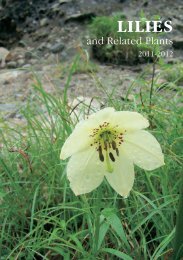LILIES - RHS Lily Group
LILIES - RHS Lily Group
LILIES - RHS Lily Group
You also want an ePaper? Increase the reach of your titles
YUMPU automatically turns print PDFs into web optimized ePapers that Google loves.
Above, Erythronium propullans. The flowers of<br />
this rare species from Minnesota are usually less<br />
than 1cm long. Above right, a leaf of E. revolutum<br />
showing the mottled pattern confined to the<br />
area between the main veins. Right, a leaf of E. dens-canis showing the random<br />
pattern of mottling, cutting across veins.<br />
recognition is justified but it is certainly distinct as a horticultural subject. Another<br />
Californian species is among those I rate highly: E. helenae. Again it is not unlike<br />
E. californicum with white flowers and mottled leaves but here the flowers have<br />
a large yellow zone in the centre and the stamens (anthers) are yellow (white in<br />
E. californicum). This is named after Mount St Helena, not Washington State’s<br />
Mount St Helens which blew its top so spectacularly in 1980.<br />
Eurasian and eastern North-American species<br />
The Eurasian species are, of course, delightful garden plants although less<br />
spectacular than the western American ones. But of course E. dens-canis does<br />
have an AGM, awarded to the species as a whole. I find that the bulbs of the<br />
named commercial clones tend to split up and form non-flowering clumps so it<br />
is necessary to try to counteract this by digging them up frequently and feeding<br />
with a potash-rich (e.g. rose) fertilizer. Plants from wild stocks or seeds tend to<br />
flower much more freely but the rate of increase is slower. To collect seeds one<br />
has to move fairly quickly for, as with Galanthus, Sternbergia and Cyclamen, the<br />
seed pods touch the ground and ants will soon remove the contents, attracted<br />
by a fleshy appendage or (in the case of Cyclamen) a sugary coat. Interestingly<br />
the Eurasian and eastern North American species of Erythronium behave in this<br />
way but the western ones all have upright capsules whose seeds are distributed<br />
85




